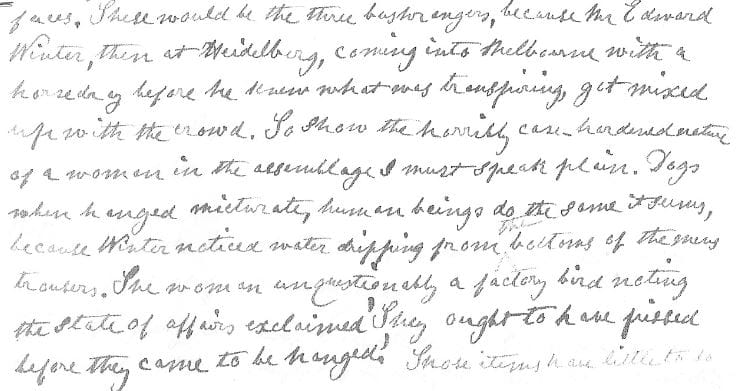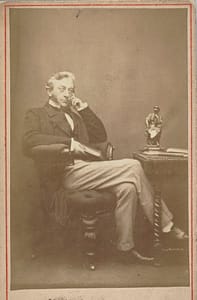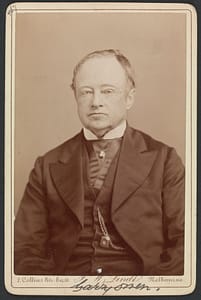In my last blog post, Edward WINTER, Mary REIBEY and the $20 note , I spoke of the wonderful legacy Isaac BATEY left in the form of ‘Notes, 1840-1850‘—recollections of European colonial pioneers in Sunbury, Victoria and surrounds—available to be viewed in the State Library of Victoria (SLV). This post deals with another reference BATEY makes to Edward WINTER, my great great grandfather and his father in law. Edward ‘accidentally’ witnesses the public hanging of 3 bushrangers in Melbourne in 1842. I say ‘accidentally’ as it appears Edward happens across the scene rather than aiming for a front row seat. A relief for his great great granddaughter—me—and his many other descendants.
Intro
It was the second public hanging to be held in the Port Phillip District. Three bushrangers, ELLIS, JEPPS and FOGARTY, were hanged on 28 June 1842 outside the partially constructed Melbourne Gaol (now known as the Old Melbourne Gaol).
The event attracted a large crowd. Edmund FINN, the journalist and author writing under the pseudonym, Garryowen, reported that there were at least 7000 people in attendance..
…and with shame be it spoken, a very large preponderance of women and children (Garryowen, p.397).
Other reports say 2000 onlookers. Whatever it was, it’s amazing to think people wanted to watch at all.
It was also reported that the onlookers used the scaffolding of the partially constructed gaol as a grandstand.
Isaac BATEY’s ‘Notes’
According to a ‘memo’ left by Isaac BATEY’s father, Martin BATEY, Edward got mixed up in the crowd as he was coming into Melbourne with a ‘horsedray’.
Below is the extract describing the reference as written in the chapter entitled:
1842 June 28th. Bushrangers hanged-there were 3 of them
(See, also, the transcript following)

Transcript:
…. These would be the three bushrangers, because Mr Edward Winter, then at Heidelberg, coming into Melbourne with a horse dray before he knew what was happening, got mixed up with the crowd. To show the horribly case-hardened nature of a woman in the assemblage I must speak plain. Dogs when hanged micturate, human beings do the same it seems, because Winter noticed water dripping from the bottoms of the mens trousers. The woman unquestionably a factory bird noting the state of affairs exclaimed ‘They ought to have pissed before they came to be hanged’…
Indeed. Charming.
The extract proffers some questions/explanations…
- how common was it to hang a dog in those days?
- ‘micturating’ — I’ll let you work that out,
- ‘factory bird’ — I suspect this was a term used for a female convict originally housed in a female factory. Below is a description of female factories of the 1830s in Van Diemen’s Land, courtesy of the University of Tasmania website:
During the 1830s, those who entered a Female Factory were divided into three classes. At the bottom in the Third or Crime Class were women serving secondary punishment for offences such as insolence, drunkenness and being absent without leave. In the Second or Probation Class, women worked at lighter tasks and enjoyed a less meagre diet. At the top in the First or Assignable Class were women waiting to be sent into private service where settlers gave them room, board and clothes, but no wages.
- ‘Edward Winter then of Heidelberg’ — This may refer to the time Edward was the farm manager/overseer of Lucerne, the property in Alphington, or, it may refer to another property a little further north—one I haven’t found yet. See blog post What’s in a name?
The above account is the only detail BATEY recorded in his ‘Notes’ of Edward’s experience of the hangings…perhaps that was all Edward bothered to tell anyone or, perhaps it was just a quirky little anecdote BATEY found amusing enough to be worthy of some posterity.
Whatever the reason, it triggered a curiosity in me: who were these bushrangers, why were they hanged and what did others report?
Who were these three bushrangers?
The three were originally four. The fourth member, John WILLIAMS, was shot dead at the time of the capture.
The youngest of the bushrangers was Charles ELLIS. He was 19 years old. ELLIS was born in Surrey, England into a very poor family. He was uneducated. He worked his passage to Australia as a ship’s cook, arriving in Sydney. He then worked his way down to Melbourne and became a ‘bullocky’.
Daniel JEPPS was 27 years old. He was Born in Boston USA and was known as ‘Yankee Jack’. (One of the captors was known as ‘Hopping Jack’. I wonder what prompted that alias?). In contrast to ELLIS, JEPPS was educated. He was a seaman/whaler. After arriving in Sydney he jumped ship (literally) at the Heads of Port Phillip Bay as the ship was leaving to return to America. He also made his way overland to Melbourne.
Martin FOGARTY was 26 years old. He was born in Templemore, Co. Tipperary, Ireland. FOGARTY migrated to Australia with John WILLIAMS. They worked together on the same station. WILLIAMS inducted FOGARTY into the gang.
ELLIS and JEPPS met up with FOGARTY and WILLIAMS and, all together, they commenced their raiding and looting. The capture of the three and the fatal shooting of WILLIAMS happened only seven weeks into their spree.
Reports of the bushranging escapades, the shoot-out and capture
The gang of four firstly raided properties in the Dandenong district. They then moved on to the Plenty river area, north of Melbourne. Eventually, there was a ‘shoot out’ on Campbell Hunter’s property in Whittlesea, between the police and the bushrangers. It’s said to have lasted for an hour.
There were several articles published in the newspapers of 1880 recounting memories of this period of time:
Thomas NAPIER, a resident of Essendon, wrote about his experience of being robbed by the bushrangers nearly 40 years earlier (Argus, 11 August 1880, p. 7.):
…I was, I believe, along with another, the first to be stuck up by them…
The robbery took place ‘on the Dandenong Road’. The gang took a watch and £2 from Napier’s companion:
They then made us ride before them for half a mile, then called on me to dismount and give up my horse to Fogarty, leaving me an old scrubber. Before leaving they gave us a drink of rum, and told us to go on our journey, threatening to shoot us if we gave information.
Governor LA TROBE put together a group of men from the Melbourne Club to help in the pursuit of the bushrangers as there were not enough police. They were sworn in as special constables.
Constable George VINGE, the leader of the band of ‘real’ police’, also wrote about his recollections of the events of 1842. The article was entitled, Bushrangers in the Olden Times and it was printed in The Argus on the 6th August 1880, p.6. It’s interesting to note that less than forty years earlier than this publication was considered ‘Olden Times’. I suppose it wasn’t too far fetched as there would have been rapid growth and change in the colony in the ensuing years.
VINGE declared:
…I was the leader of the party that captured them…
He reported that the bushrangers had ‘stuck up and robbed’ at least 6 properties in the Plenty as well as others ‘on the road’.
The bushrangers were eventually taken by surprise. They set up ‘a determined resistance’ in a hut. After an hour-long shoot out, WILLIAMS was dead and one of the captors, named FOWLER, had been shot in the face.
FOGARTY surrendered first. A short time later JEPPS came out of the hut. He asked the captors…
…if any of our party had been shot and coolly stood beside the hut lighting his pipe with banknotes, the remnants of which were picked up afterwards.
JEPPS asked his captors to let him go. On denial of this he made another request:
Gentlemen rather than be taken to Melbourne and made a public show of on the gallows, shoot me.
This request was also denied. VINGE then made his move…
…I walked up and handcuffed him, and upon searching him found £10 wrapped up in his neckerchief.
Meanwhile, Hopping Jack and another had entered the hut and after a short while ELLIS came out and surrendered. ELLIS had a go at VINGE but VINGE ‘knocked him down’. ELLIS requested to see ‘his mate Williams’. The captors agreed and took him over to the hut where Williams lay…
When he saw the dead body of Williams he (Ellis) knelt down and kissed it.
VINGE handcuffed the three prisoners to each other and ‘mounted them on separate horses’.
The captors and their charges arrived in Melbourne on a Sunday. The news of their capture had already reached the town…
…hundreds of people met us on our way and to show how great was the excitement people rushed out of the churches leaving the preacher alone in the pulpit.
The Trial and Hangings

On 11th May 1842, ELLIS, FOGARTY and JEPPS were charged by Resident Judge WILLIS with ‘shooting with intent to kill at Whittlesea on 29 April 1842’. Shooting with intent to kill was a capital offence in the colony at the time.
Jepps turned to religion after the trial and assumed a leadership role in preparing his companions for their fate. Jepps largely kept his composure on the gallows and gave a speech exhorting people not to turn to crime – “I trust you will all take warning by our untimely fate, and avoid those crimes which have brought us to this end…” He then blessed the hangman, who shook hands twice with all three victims….Jepps’ last words were: “God bless you and your poor soul. Farewell.” (Poultney, p.4)
According to Garryowen, Melbourne was ‘hero-mad’ in the interval between the condemnation and execution:
…and the air, so to speak, rang with the praises of the five gallant volunteers who so bravely brought them to justice.

It was agreed at a public meeting ‘to present the volunteers with an address and a case of pistols each, as well as to entertain them at a public dinner’.
The prisoners were visited by their various religious pastors. They became very penitent and asked to see one of their captors, Mr Fowler, the man who was shot. The request was granted. On meeting with the captor…
…they dropped on their knees and asked his forgiveness, which he freely gave, and kindly shook hands with them on leaving.
It was revealed that if they hadn’t been caught they were intending to murder Judge WILLIS. On the day of the hangings, ‘a large cart, with three rough coffins placed in it, was driven up to the gaol door’. The handcuffed and capped prisoners ‘mounted the cart, and each with his back to the horse, sat down upon his coffin!’
Garryowen infers astonishment at the sight :
“Swells” from the neighbourhood of the town, and from all the country for miles around: and as before, well-mounted smartly dressed settlers, with top boots and cord breeches, cantered about as if out on some equestrian spree. It appeared like a great gala celebration instead of the punishment of three guilty fellow-creatures.
It’s good to know ‘our Edward’ was not one of the “swells”.
Following the hangings, all three men were buried outside the Old Melbourne Cemetery. This site is presently covered by The Queen Victoria Market.
And for anyone interested in ‘Early Melbourne’…
Below is a wonderful depiction of Melbourne in 1854. It was drawn by the artist Nathaniel WHITTOCK from sketches done by a G Teale. I’ve circled the site of the (Old) Melbourne Gaol. As you can see, the gaol was on the outskirts of town and no doubt even more distant from the hubbub in 1842.
For a better view of the numbered landmarks and the corresponding legend the picture can be accessed and downloaded from the SLV website. Click here.

References:
Most of the information regarding the three bushrangers was taken from the following resources:
Finn, Edmund (Garryowen), The Chronicles of Early Melbourne, 1835-1853, Fergusson and Mitchell, Melbourne, Australia, 1888.
Poultney, Trevor, Victims of the Rope: Executions in Port Phillip & Victoria 1842-1967, Trevor Poultney, Melbourne, 2016.
And, if you’re interested in Judge Willis, the first judge of Port Phillip, read on:
The Resident Judge of Port Phillip Who was Judge Willis? Blog by Janine Rizzetti.
The Judge Willis Casebooks Royal Historical Society of Victoria.
Great post. So interesting to have your forebear’s insights. Coincidentally I was at an excellent Latrobe Society lecture on these bushrangers and their hanging last week. There is an exhibition at the Old Treasury Building in Melbourne on bushrangers and this incident is included in the documents and artefacts on display.
Regards
Anne
———-
Anne Young
Anne’s family history
Thanks for the comment Anne. I’m very lucky to find a memoir that mentions my forebear.
Yes, I’ve seen the exhibition in the Treasury. In fact a funny thing happened-some American tourists started taking photos of the documents pertaining to the 3 bushrangers after they saw me poring over them. Goodness knows what they told their friends and family back home.
The lecture would’ve have been good too..if only there was more time!
Cheers, Marg
Interesting Marg and a rather sobering event for poor Edward to come across! Rosemary x
Thanks Rosemary. Yes! I can’t believe people thought that was entertainment. x
A good read, Marg. So you do have bushrangers in your side of the family tree !
Thanks Brian. Who knows what else will turn up!
Hey Marg, have you seen Great Great Grandad Lee’s Melbourne Map print?
Hi Theresa,
I presume you mean this one from 1873? http://nla.gov.au/nla.obj-230007895/view
It’s fabulous isn’t it. What a talented man he was. A complete revelation to me and my family!
Marg